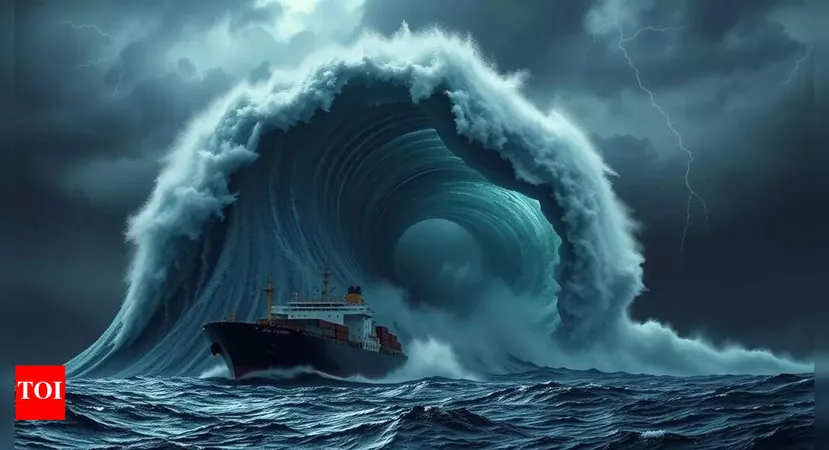
The Hidden Dangers of Rogue Waves: How They Can Devastate Shipping Lanes
2025-09-01
Author: Emily
Rogue Waves: The Silent Killers of the Sea
Rogue waves, unpredictable and immense, represent a serious risk to maritime safety, causing catastrophic losses at sea. The fates of the MS München and MV Derbyshire serve as chilling reminders of their potential devastation.
Tragic Histories: Lost Ships and Their Crew
Mystery surrounds the disappearance of the MS München, an 850-foot vessel believed to have been struck by a monstrous wave in the unforgiving North Atlantic. Following a distress call received in December 1978, all 28 crew members were lost, and the ship sank without a trace. Similarly, the MV Derbyshire, a 964-foot cargo carrier, sank within minutes during a storm in the South China Sea in 1980, marking it as the largest British-flagged ship to vanish at sea without a distress signal. Its wreck was discovered years later, lying four kilometers deep near Okinawa, Japan. Both tragedies hint at the wrath of rogue waves, which can tower at least twice the height of surrounding waves.
Understanding Rogue Waves: Theories Behind Their Formation
Rogue waves emerge suddenly, boasting tall crests and deep troughs, often disappearing within moments. Experts have proposed two primary theories for their formation: one suggests that waves traveling at different speeds converge to form a gigantic wall of water, while another posits that smaller waves may coalesce their energy into a single, larger wave. Despite enhanced ship designs since the 1980s, modern vessels still face challenges against these colossal forces.
The Role of Climate Change and Advanced Technology
Research indicates that wind plays a key role in the creation of rogue waves. As atmospheric energy is transferred to the ocean surface, stronger winds result in stormier seas and higher chances of extreme waves. Experts also warn that climate change could amplify this issue, with predictions of increasing winds tied to global warming. Amin Chabchoub from the Okinawa Institute of Science and Technology explains that while stronger winds lead to larger waves, the relationship is complex due to changing ocean currents.
The Increasing Frequency of Rogue Waves
Recent studies reveal that rogue waves may occur more frequently than previously believed. During a 2017 expedition, scientists documented rogue waves twice the height of their neighbors surfacing every six hours in the southern ocean, where conditions allow waves to flourish without interference from land. In the Indian Ocean, researchers logged numerous “freak wave events,” confirming that rogue waves can occur in these waters as well.
AI: A Beacon of Hope in Predicting Rogue Waves
Advancements in artificial intelligence could soon change the game for rogue wave forecasting. Researchers at the University of Maryland developed a tool that uses machine learning to predict rogue waves up to five minutes in advance—a critical timeframe that could save ships from disaster. Thomas Breunung, one of the lead researchers, stresses the importance of accurate data in training AI models to detect these phenomena reliably.
The Future of Maritime Safety: Combining AI and Real-time Data
Experts believe that integrating AI with real-time buoy and satellite data will revolutionize rogue wave prediction. As Francesco Fedele from the Georgia Institute of Technology notes, the aim is to quantify the probability of rogue waves through deep learning models that can discern hidden patterns in wave behavior. By improving forecasting accuracy, lives can be saved, and maritime safety can be substantially enhanced.









 Brasil (PT)
Brasil (PT)
 Canada (EN)
Canada (EN)
 Chile (ES)
Chile (ES)
 Česko (CS)
Česko (CS)
 대한민국 (KO)
대한민국 (KO)
 España (ES)
España (ES)
 France (FR)
France (FR)
 Hong Kong (EN)
Hong Kong (EN)
 Italia (IT)
Italia (IT)
 日本 (JA)
日本 (JA)
 Magyarország (HU)
Magyarország (HU)
 Norge (NO)
Norge (NO)
 Polska (PL)
Polska (PL)
 Schweiz (DE)
Schweiz (DE)
 Singapore (EN)
Singapore (EN)
 Sverige (SV)
Sverige (SV)
 Suomi (FI)
Suomi (FI)
 Türkiye (TR)
Türkiye (TR)
 الإمارات العربية المتحدة (AR)
الإمارات العربية المتحدة (AR)